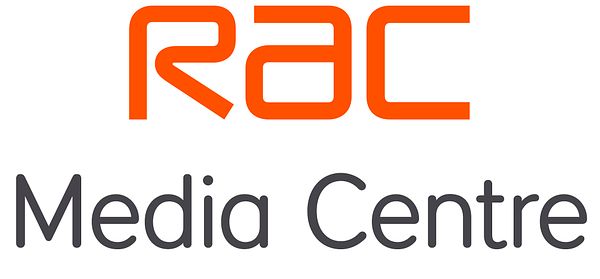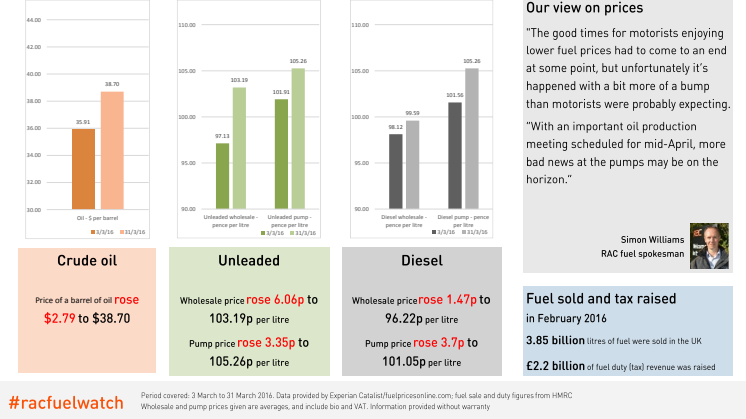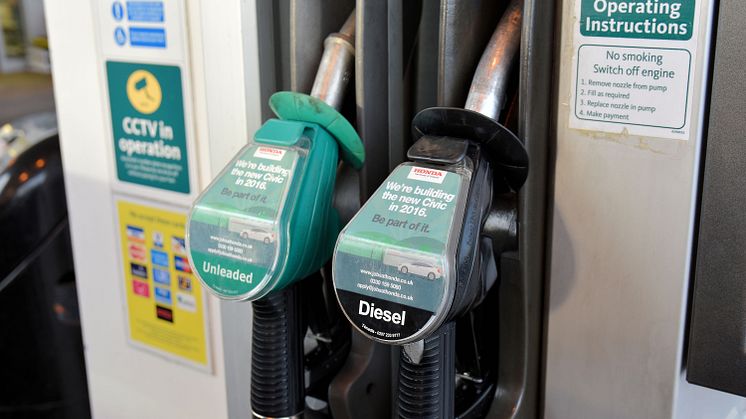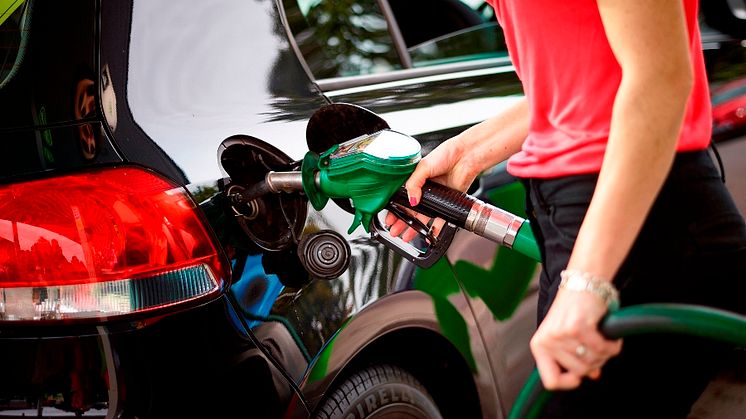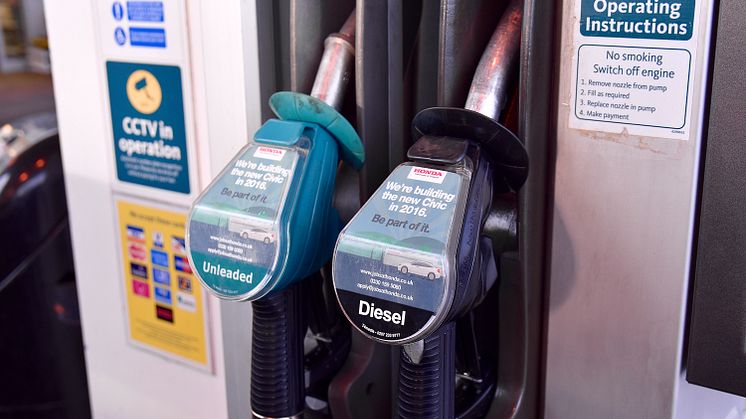
Press release -
Price of petrol goes up 3p a litre in March signalling first rise since July 2015
After eight months of falling pump prices RAC Fuel Watch data* reveals the average price of petrol suffered a sudden and unwelcome 3p a litre rise in March as oil went back above $40 a barrel for the first time since 4 December last year.
The cost of a barrel of oil increased 8% from $35.91 on 3 March to $38.70 at month end causing the first upward shift in forecourt petrol prices since July 2015. At the start of March the average price of a litre of petrol was 101.91p but by the close it was 105.26p – an increase of more than 3p – which added £1.84 to the cost of filling up an average 55-litre car – £57.89.
The wholesale price of petrol, including VAT, increased 6p a litre from 97.13p to 103.19p, suggesting that the pump price is likely to go up again in the coming weeks.
Supermarket fuel prices, which are traditionally the lowest in the country, also went up. At the start of March, the average supermarket price of a litre of petrol was 99.88p but by month end a litre cost 102.19p – a rise of more than 2p.
Worryingly, RAC Fuel Watch data for March shows diesel forecourt prices also increased by 3.7p a litre – 101.56p to 105.26p – even though the wholesale price only rose by 1.5p a litre (98.12p to 99.59p), adding £2 to the cost of a 55-litre tank. This indicates that retailers are once again either using the lower diesel wholesale cost to subsidise the price of petrol or using it as a means of increasing their profit margin. At supermarkets the average price of diesel rose equally dramatically – 3.5p a litre – from 98.57p to 102.09p.
RAC fuel spokesman Simon Williams said: "The good times for motorists enjoying lower fuel prices had to come to an end at some point, but unfortunately it’s happened with a bit more of a bump than motorists were probably expecting. With an important oil production meeting scheduled for mid-April, more bad news at the pumps may be on the horizon.”
The price of a barrel of oil went up significantly in March, going over the $40-mark for four days in the middle of the month before dropping back to $38 by month end. While the world is still producing far more oil than it needs, a meeting between OPEC and non-OPEC countries to discuss limiting output is due to take place in Qatar on 17 April.
Simon Williams added: “An earlier meeting between OPEC and non-OPEC countries responsible for nearly 75% of the world’s oil production led to output being restricted to January levels. While this helped to revive oil prices, producers clearly still feel a further limit on production is needed. This is bad news for motorists as it will inevitably lead to more price rises on the forecourt.
“We hope the rebound in pump prices will be limited by the fact that OPEC will not want to let the price go too far back up. Otherwise all their work aimed at safeguarding their market share will be undermined by oil production from fracking in the US being stepped back up again if oil goes back above $60 a barrel – the recognised point at which fracking becomes financially viable. For this reason, it looks as though we are heading towards a new norm of the oil price fluctuating between lower and upper limits of $35 and $55 a barrel.
“This means that motorists should hopefully not see the eye-watering prices they were paying at the pumps in April 2012 when the average price of petrol was 142p and diesel was close to 150p per litre. Motorists will also be relieved that the Chancellor saw sense and listened to the RAC and other campaigning groups by extending the freeze on fuel duty in his Budget.”
UK fuel price variation
Around the UK, Wales saw the biggest increase in average petrol prices – 3.7p – from 101.4p to 105.1p. Average diesel prices went up most in East Anglia – 3.88p – from 101.49p to 105.37p.
| Petrol - ppl | 03/03/2016 | 31/03/2016 | Change | |
| 1 | Wales | 101.40 | 105.10 | 3.70 |
| 2 | East Anglia | 101.57 | 105.21 | 3.64 |
| 3 | West Midlands | 101.98 | 105.51 | 3.53 |
| 4 | South East | 101.98 | 105.48 | 3.50 |
| 5 | South West | 101.83 | 105.27 | 3.44 |
| 6 | North | 101.76 | 105.05 | 3.29 |
| 7 | North West | 102.07 | 105.28 | 3.21 |
| 8 | Scotland | 101.94 | 105.13 | 3.19 |
| 9 | East Midlands | 102.25 | 105.40 | 3.15 |
| 10 | Yorkshire And Humber | 101.77 | 104.78 | 3.01 |
| 11 | Northern Ireland | 101.42 | 103.97 | 2.55 |
| Diesel - ppl | 03/03/2016 | 31/03/2016 | Change | |
| 1 | East Anglia | 101.49 | 105.37 | 3.88 |
| 2 | South East | 101.73 | 105.52 | 3.79 |
| 3 | North West | 101.52 | 105.29 | 3.77 |
| 4 | Wales | 101.34 | 105.08 | 3.74 |
| 5 | South West | 101.77 | 105.47 | 3.70 |
| 6 | West Midlands | 101.64 | 105.33 | 3.69 |
| 7 | East Midlands | 101.72 | 105.37 | 3.65 |
| 8 | Yorkshire And Humber | 101.21 | 104.79 | 3.58 |
| 9 | North | 101.41 | 104.97 | 3.56 |
| 10 | Northern Ireland | 100.49 | 104.02 | 3.53 |
| 11 | Scotland | 101.69 | 105.19 | 3.50 |
Motorists can keep abreast of the latest fuel prices by visiting: rac.co.uk/fuelwatch or following #racfuelwatch on Twitter.
Topics
Categories
If you are a journalist and would like further information, please contact:
RAC press office: press.enquiries@rac.co.uk
Notes to Editors
* The March RAC Fuel Watch report is based on an analysis of Experian Catalist average prices from 3-31 March. Experian Catalist did not produce average prices for 1 & 2 March.
About the RAC
With more than eight million members, the RAC is one of the UK's most progressive motoring organisations, providing services for both private and business motorists. Whether it's roadside assistance, insurance, buying a used car, vehicle inspections and checks, legal services or up-to-the-minute traffic and travel information – the RAC offers a solution for all motoring needs. The RAC is committed to making motoring easier, safer, more affordable and more enjoyable for drivers and road users.
The RAC is the motorist’s champion and campaigns to support the interests of its members and UK motorists at a national level, including advancing levels of road safety, supporting the needs of young drivers and voicing concerns about the increasing cost of motoring. The RAC’s annual Report on Motoring – first published in 1989 – provides a clear insight into the concerns and issues facing today’s motorists.
For the very latest news on UK fuel prices, check RAC Fuel Watch or follow #racfuelwatch on Twitter. This is a comprehensive guide to the latest UK unleaded petrol and diesel prices – both at the wholesale level and at the pump. RAC Fuel Watch analyses how prices changed through the previous month and compares the most recent prices with those from three, six and 12 months before.
Key facts:
- RAC patrols fix four out of five vehicles at the roadside and on average within 30 minutes
- RAC vans carry more than 500 parts and tools to get members’ vehicles going again
- 92% of members would recommend RAC Rescue to their friends and family
